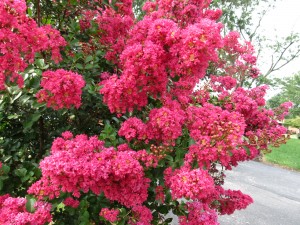Undeniably, crape myrtles (Lagerstroemia indica x L. faurei ) thrive in the southern U.S. (USDA hardiness zones 6-9). You see them planted on practically every street. Their showy summer flowers are spectacular. Many cultivars exhibit colorful autumn foliage, and their smooth patterned trunks and architecture grace the winter landscape.
“The right crape myrtle for the right site” is the golden rule here. Before visiting the garden center to make your purchase, measure the intended space where it will be planted. The plant tag will provide the flower color, as well as its height and spread. Is the cultivar hardy where you reside. Cultivars named after Indian tribes (there are 33 of them) are among the hardiest (several zone 6 hardy) and are resistant to some insects and diseases.
“Variety is the spice of life” and crape myrtles surely fit this adage. They serve a number of landscape uses. They make a large deciduous hedge or screen. Plant a single tree for accent or group several together for a formal hedge or screen. Will it be the right size for your site? Dwarf shrub forms as low as 3 feet and tall trees upwards of 30 feet are available.
The larger crape myrtles need room to grow. Stay a proper distance from buildings, power lines, or walkways. Medium-size types grow 10 to 15 feet tall and wide, perfect fits for small urban spaces. The dwarf selections are attractive in large containers or as part of your home foundation. Container plants will require winter protection.
Crape myrtles love sun and well-drained soil. Flower production is greatly declines in light shade and disease problems ramp up in shade. One-year established crape myrtles demonstrate above average drought tolerance.


 Posted in
Posted in 
